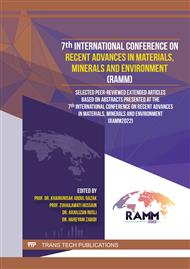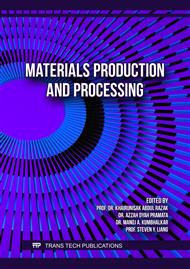[1]
C. Meidiana, T.Gamse. Development of waste management practices in Indonesia, European J. Scien Res 40(20) (2010) 199-210.
Google Scholar
[2]
Purkayastha, D.; Sarkar, S. Physicochemical Structure Analysis of Chitin Extracted from Pupa Exuviae and Dead Imago of Wild Black Soldier Fly (Hermetia Illucens). J. Polym. Environ. 2020, 28
DOI: 10.1007/s10924-019-01620-x
Google Scholar
[3]
A.A. Kadir, N.W. Azhari, S.N Jamaludin. An overview of organic waste in composting, MATEC Web of Comference 47 (2016) 05025.
DOI: 10.1051/matecconf/20164705025
Google Scholar
[4]
D. Sarpong, S. Oduro-Kwarteng, S.F. Gyasi, R. Buamah, E. Donkor, E. Awuah, M.K Baah. Biodegradation by composting of municipal organic solid waste into organic fertilizer using the black soldier fly (Hermetia illucens) (Dipteria: Stratiomyidae) larvae, Inter J. Recycling Organic Waste in Agriculture 8 (2019) 45-54.
DOI: 10.1007/s40093-019-0268-4
Google Scholar
[5]
S. Pintowantoro, Y. Setiyorini, A.M. Aljauhari, F. Abdul, H. Nurdiansah. Black soldier fly biowaste treatment and its recycle waste to produce chitosan, IOP Conf. Series: Earth and Environmental Science 649 (2021) 012004.
DOI: 10.1088/1755-1315/649/1/012004
Google Scholar
[6]
A. Wasko, P. Bulak, M.P. Berecka, N. Katarzyna, C. Polakowski, A. Bieganowski. The first report of the physicochemical structure of chitin isolated from Hermetia illucens, Inter J. Bio Macromole 92 (2016) 316-320.
DOI: 10.1016/j.ijbiomac.2016.07.038
Google Scholar
[7]
R.C. Cheung, T.B. Ng, J.H. Wong, W.Y. Chan. Chitosan: An Update on Potential Biomedical and Pharmaceutical Applications. Mar Drugs. 14 (2015) 5156-86.
DOI: 10.3390/md13085156
Google Scholar
[8]
T. Chandy, C.P. Sharma. Chitosan-as a biomaterial. Biomater. Artif. Cells Artif. Organs, 18 (1990) 1–24.
Google Scholar
[9]
M. Kmiec, L. Pighinelli, M.F. Tedesco, M.M. Silva, V. Reis. Chitosan-properties and applications in dentistry. Advances in Tissue Engineering and Regenerative Medicine, 2 (4) (2017) 205-11.
Google Scholar
[10]
L. Shue, Z. Yufeng, U. Mony. Biomaterials for periodontal regeneration, Biomatter 2 (4) (2012) 271-7.
DOI: 10.4161/biom.22948
Google Scholar
[11]
A. Susanto, M.S. Satari, B. Abbas, R.S.A Koesoemowidodo. Fabrication and characterization of chitosan-collagen membrane from barramundi (lates calcarifer) scales for guided tissue regeneration, Eur J Dent 13 (2019) 370-5
DOI: 10.1055/s-0039-1698610
Google Scholar
[12]
N. Wathoni, N. Yuniasih, A. Cahyanto, M. Muhctaridi. α -mangostin hydrogel film based chitosan – alginate for recurrent aphthous stomatitis, Appl. Sci 9 (5235) (2019) 1-14.
DOI: 10.3390/app9235235
Google Scholar
[13]
Ospina, N., Alvarez, S., Sierra, D., Ocampo, P., and Orozco, C. Isolation of chitosan from ganoderma lucidum mushroom for biomedical application. Journal of Material Sciences, 2015, 26(135), 1-9.
DOI: 10.1007/s10856-015-5461-z
Google Scholar
[14]
L. Soetemans, M. Uyttebroek, L. Bastiaens. Characteristics of chitin extracted from black soldier fly in different life stages, Inter J. Biological Macromolecules 165 (2020) 3206-3214.
DOI: 10.1016/j.ijbiomac.2020.11.041
Google Scholar
[15]
R.Q. Qian, R.W. Glanville. Methods for purifying chitosan, US Patent US006896809B2 (2005)
Google Scholar
[16]
S. Paul, A. Jayan, C.S. Sasikumar, S.M. Cherian. Extraction and purification of chitosan from chitin isolated from sea prawn (fenneropenaeus indicus), 7 (4) (2014) 201-204.
Google Scholar
[17]
M.M, Islam, S.M. Masum, M.M. Rahman, M.A.I. Molla, A.A. Shaikh, S.K. Roy. Preparation of chitosan from shrimp shell and investigation of its properties. International Journal of Basic & Applied Sciences. 11(2011) 77-80.
Google Scholar



